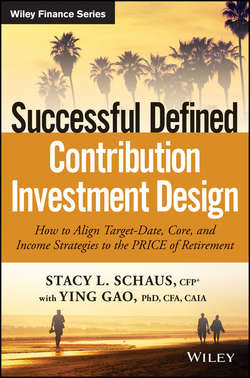Читать книгу Successful Defined Contribution Investment Design - Gao Ying - Страница 13
На сайте Литреса книга снята с продажи.
PART ONE
DC Plans: A Cornerstone of Retirement
CHAPTER 1
DC Plans Today: An Overview of the Issues
SETTING GOALS FOR SUCCESS: INCOME REPLACEMENT TARGETS
ОглавлениеWhether you’re a multinational plan sponsor, a single market, or a public employer, we know that for a DC plan to succeed, that plan may need to deliver an old-age income stream to last 20 to 30 years in retirement – or perhaps even longer. Consultants surveyed in PIMCO’s 2016 Defined Contribution Consulting Support and Trends Survey suggest that plan sponsors set an income replacement target at 80 percent of final pay, including Social Security and other income sources. They suggest that a DC plan will need to replace 60 percent of a worker’s final pay for those who lack both a DB plan and paid retiree medical coverage – which is the case for the vast majority of U.S. workers. We know that the percentage of income replacement will vary broadly based on the income level and personal circumstances of workers. Whatever the percentage, most DC plans share a common goal: to help workers retire at their desired age and with sufficient income to maintain their lifestyle throughout retirement. For organizations that also provide a DB plan, the DC income replacement target may be only 30 percent. What’s important is to consider the objective for your plan and set a reasonable target.
In December 2014, we interviewed Philip S. L. Chao, Principal and Chief Investment Officer of Chao & Company Ltd., a retirement plan and fiduciary consulting firm, about their approaches to DC investment design. He shared the followed comments:
We begin with a basic question: “What is the objective for this plan?” It is rare for us to set up a new plan; rather, we’re typically asked to advise on an existing plan. With that said, it may be surprising how much time we spend on the plan’s objective. We ask the plan sponsor to forget about how the plan is designed today; they are encouraged to step back and identify what they are trying to accomplish. This often leads to a refreshing discussion of the DC plan as a benefit program and the outcome they seek for their participants. Yet, plan sponsors are rarely specific about the desired outcome. Instead, we often initially hear they simply want a competitive plan, or they may tell us how a DC plan is the only retirement savings vehicle employees have. We then work with the plan sponsors to articulate and document the objective for the plan. Once the objective is set, then we work on crafting the investment structure to help meet this objective.
Chao goes on to tell us more about setting an income replacement target, saying:
We consider the organization’s workforce (i.e., thinking in sole interest of the participants) and the retirement income sources for the typical employee. A law firm’s demographics, income distribution and other factors may differ greatly from a retail chain store. The law firm may have higher-paid workers and lower turnover. These are important considerations as we think about the median worker profile. Median is not perfect either, but it’s a start. We consider Social Security, likelihood of the existence of other retirement plans, housing wealth, and other retirement income sources.
In general, plans consider a 75 % to 80 % income replacement as the default target, including Social Security. About half of that need can be covered by Social Security and other income sources. This leaves DC plans to fill in the remaining 35 % to 40 % of income for the median worker over the course of a working career. This isn’t exact and won’t fit all workers, but a general target helps us as we consider the plan design. We ask ourselves whether the median participant is likely to meet their income needs. We want the plan sponsor to understand the probability of failure and whether the plan is likely to meet the set objective. This goes beyond investment return and pulls in the average deferral rate, employer contribution amount and other assumptions. Assessing the likelihood of meeting the plan’s objective can help plan sponsors evaluate target-date funds and other QDIAs [Qualified Default Investment Alternatives] as well as test the balance in and portfolio construction adequacy of their core lineup.
While DC plans need to focus on meeting participant needs and consultants tell us that the number one driver of plan sponsor decisions is to “meet participant retirement goals,” they also note that the second driver is to “manage litigation risk” (PIMCO’s 2016 Defined Contribution Consulting Support and Trends Survey). Sound plan governance and plan oversight are central to both of these. Before delving deeply into meeting a retirement objective, let’s take a look at litigation and fiduciary duties.
